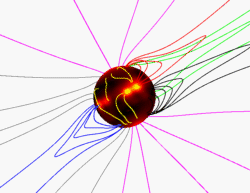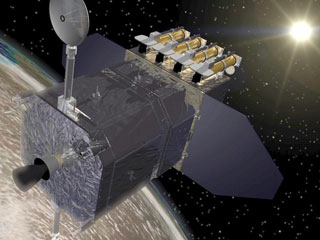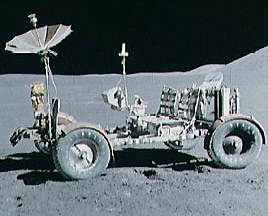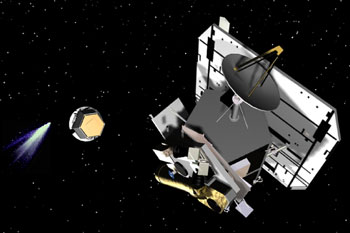This is what an artist thinks NASA's Solar Dynamics Observatory (SDO) looks like in orbit around Earth.
Click on image for full size
Image courtesy of NASA/Goddard Space Flight Center Conceptual Image Lab.
Solar Dynamics Observatory
Solar Dynamics Observatory (SDO) is a satellite which studies the Sun. SDO carries several telescopes and other instruments for observing the Sun. The cameras on SDO take much better pictures than cameras on earlier orbiting solar observatories did. SDO was launched in February 2010. It will study the Sun for 5 years as part of NASA's Living With a Star program.
SDO carries three instruments: HMI, EVE, and AIA. The Helioseismic and Magnetic Imager (HMI) studies the Sun's interior and the Sun's magnetic field. The Extreme Ultraviolet Variability Experiment (EVE) records changes in the total amount of ultraviolet radiation coming from the Sun. UV rays from the Sun have a strong influence on Earth's upper atmosphere. The Atmospheric Imaging Assembly (AIA) take really nice pictures of the Sun at various UV wavelengths.
You might also be interested in:

Text for this level has not been written yet. Please see the "Intermediate" text for this page if you want to learn about this topic. To get to the "Intermediate" text, click on the blue "Intermediate"
...more
Solar Dynamics Observatory (SDO) is a satellite which studies the Sun. SDO carries several telescopes and other instruments for observing the Sun. The cameras on SDO take much better pictures than cameras
...more
The Hubble Space Telescope (HST) is really neat! It was first launched in 1990, but scientists started building it in the 1970's! We have found all kinds of objects like stars, nebulae and galaxies. The
...more
Apollo 11 was the first mission that landed a person on the moon. On July 16, 1969, the U. S. rocket Saturn 5 was launched carrying the lunar landing module Eagle. The Eagle was released and it reached
...more
Apollo 12 was launched on Nov. 14, 1969 and arrived at the Moon three days later. Astronauts Charles Conrad and Alan Bean descended to its surface, while Richard Gordon remained in lunar orbit aboard the
...more
Apollo 15 marked the start of a new series of missions from the Apollo space program, each capable of exploring more lunar terrain than ever before. Launched on July 26, 1971, Apollo 15 reached the Moon
...more
NASA chose Deep Impact to be part of a special series called the Discovery Program. This program is for cheap, scientific projects. In May 2001, NASA said it was ok to start with mission development for
...more














